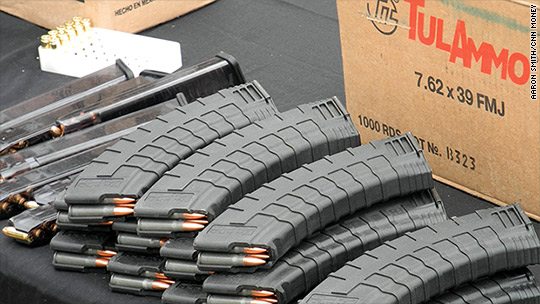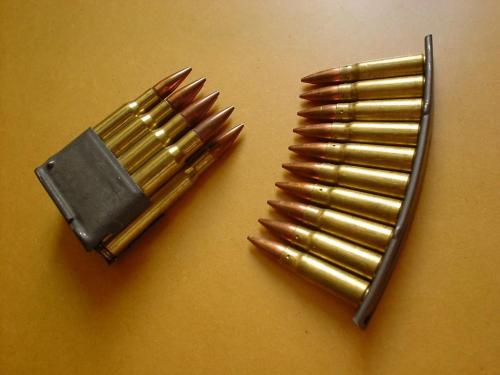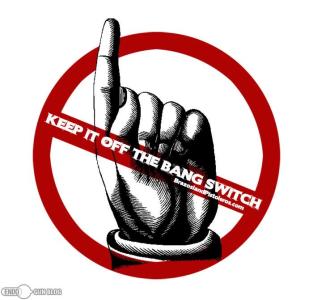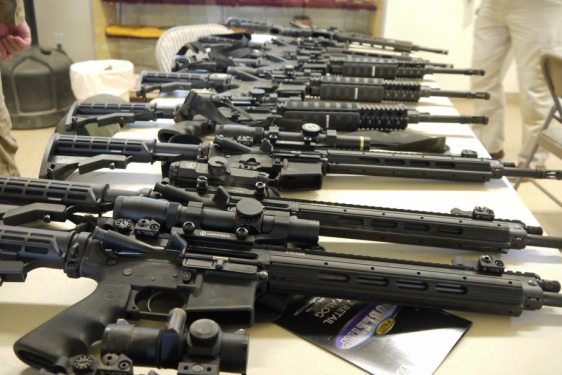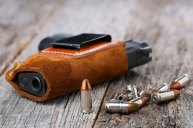Read on to learn some of the misused gun terms that gun owners are sick of.
When it comes to guns, there are many misused and confused terms, along with a few that are just made up. Some of these misused gun terms just reflect ignorance on part of the user. Others are intentionally misleading terms developed by anti-gun groups in order to demonize guns and frighten those who just don't know any better. Regardless of the reason, when it comes to the misused gun terms on this list, you should either use them correctly (in the case of the often confused terms) or avoid them all together.
1. High Capacity Magazine
So what exactly is a high capacity magazine? Well, since this misused gun term was invented by the anti-gun lobby, it is necessarily inexact and vague. The Federal Assault Weapons Ban of 1994 defined a high capacity magazine as one that could hold more than 10 rounds. However, the definition varies by jurisdiction. For instance, Colorado and New York drew the line at 15 and 7 rounds respectively.
The definition of a high capacity magazine is also arbitrary, which was the same reason the New York definition of 7 rounds was struck down in Federal Court. The exact words used by the judge were that the ban was "an arbitrary restriction that impermissibly infringes on the rights guaranteed by the Second Amendment (full decision here)."
At the same time, the term is also frightening to those who aren't familiar with guns by giving the impression that these magazines are something scary or unusual. In fact, the exact opposite is true. For example, the Glock 17 was designed to be used with a 17-round magazine and an AR-15 comes from the factory with a 30-round magazine. Even though certain places would classify those as high capacity magazines, the term standard capacity magazine is actually a much better name for them.
For these reasons, you should drop the term "high capacity magazine" from your vocabulary. Instead, use the term "standard capacity magazine" or just simply "magazine."
2. Clip
This is one of the most commonly confused and misused gun terms that drives gun owners crazy. The fact that there is such a thing as a clip and that it serves a similar function as a magazine makes it easy to confuse the terms. However, a clip is not the same as a magazine and the terms are not interchangeable.
Yes, both a clip and a magazine and a clip hold cartridges. However, clips, like the en bloc clip for the M1 Garand and the SKS stripper clip below, were designed to quickly load magazines. Clips do not have moving parts. Magazines, on the other hand, are ammunition storage devices that use a spring to feed cartridges directly into the chamber of a firearm. That's the basics of the differences, but if you want to go into more detail, check out this article at the Gun Zone.
Though reporters and anti-gun advocates are some of the most frequent offenders here, there are a number of gun owners who misuse the term clip as well. So, unless you want to sound like this clueless anti-gun politician to your friends, don't call a magazine a clip.
3. Accidental Discharge
Similar to the terms clip and magazine, the terms accidental and negligent discharge are often confused. It may seem like a small distinction, but this is another one of those misused gun terms responsible gun owners are really tired of hearing people use incorrectly. Yes, there is such a thing as an accidental discharge. However, the vast majority or unintentional discharges are actually better described as negligent discharges.
Put simply, an accidental discharge is a failure of the firearm while a negligent discharge is a failure on part of the operator.
When an event is described as accidental, it gives the impression that it was not anyone's fault. For a genuine accidental discharge, this is true. However, negligent discharges are by definition, somebody's fault. For instance, this guy was pretty clearly negligent in the manner he handled that shotgun. The shotgun worked exactly like it was supposed to and fired when he pulled the trigger, so this was a negligent discharge and not an accidental discharge.
The next time you describe an unintentional discharge of a firearm, make sure you only call it an accidental discharge if it really was an accident and not the result of negligence on part of the operator.
4. Common Sense Gun Safety
This term really first started appearing in the media a few years ago after the Newton Shooting. When gun owners use the term "gun safety", they're probably referring to something along the lines of the 4 Rules of Firearm Safety, securely storing firearms when they are not in use, or training new gun owners how to properly use their guns. However, gun control advocates have recently hijacked the phrase and started using it to promote the same old gun control laws wrapped in a different package.
Truth be told, adopting the term was a pretty clever marketing ploy on their part. Like several of the other misused gun terms on this list, "Common Sense Gun Safety" was designed to convince people who were not familiar with guns that these were reasonable proposals, while at the same time portraying gun rights activists as unreasonable and reckless. After all, it's tough to argue against something that is billed as "Common Sense."
In reality, virtually every gun control proposal deemed "Common Sense" by gun control advocates is actually anything but. Not only would these proposals make virtually no positive impact on crime in the USA, but they typically wouldn't even have prevented the tragedy being used to justify the proposed gun control law!
Take the "Common Sense Gun Safety" regulations proposed after the mass shooting in San Bernardino as an example: ban "assault weapons" (more on this term later), ban "high capacity magazines", institute mandatory background checks for all firearm transfers, and block people on the "No Fly List" from purchasing firearms. Well, if you consider the fact that "assault weapons" are already banned in California and the shooters illegally modified the guns they used, they used high capacity magazines that were also illegal to own in California, the original owner of the guns passed a background check and transferred them privately to the shooters in violation of California law, and that the shooters were not ever on the "No Fly List" or any other terrorism watch list, it should be pretty clear that these proposals that were billed as "Common Sense" would not have prevented that tragedy (or any other one for that matter) if enacted beforehand. Instead, the term "Common Sense" was merely being used as a stalking horse for the same gun control laws that the same anti-gun groups have been trying to push through for the last few decades.
Avoid this term like the plague because the only people who use it are those who are completely clueless about guns and those who are intentionally trying to deceive other people who are also clueless about guns.
5. Assault Weapon
Of all the words in the firearms vocabulary, the term assault weapon is perhaps the most hated by law abiding gun owners. Just like the term high capacity magazine, the term assault weapon is a vague and deliberately deceiving term used by gun control advocates as a means of influencing the gun control debate by frightening people who weren't familiar with guns. By inventing a scary sounding class of firearms that could be easily confused with the assault rifles used by the military, they hoped mobilize enough public support for an outright ban on these firearms (and were temporarily successful).
According to research done by Bruce H. Kobayashi and Joseph E. Olson:
Prior to 1989, the term 'assault weapon' did not exist in the lexicon of firearms. It is a political term, developed by anti-gun publicists to expand the category of 'assault rifles' so as to allow an attack on as many additional firearms as possible on the basis of undefined 'evil' appearance.
So, if they hoped to expand the category of "assault rifles", just what exactly is an assault rifle? Well, according to Army intelligence document FSTC-CW-07-03-70: "Small Arms Identification and Operation Guide - Eurasian Communist Countries" by Harold E. Johnson in November 1970 (view the original here):
Assault rifles are short, compact, selective-fire weapons that fire a cartridge intermediate in power between submachinegun and rifle cartridges.
By this definition, the AK-47 and M-16 are both examples of assault rifles. However, a key part of the definition is the fact that assault rifles are selective fire, which means they may fire both in semi-automatic (one shot per pull of the trigger) and automatic (more than one shot per pull of the trigger) modes. For this reason, an AR-15 is not an assault rifle. And no, the AR in AR-15 does not stand for Assault Rifle either. It stands for ArmaLite Rifle, the company that developed the AR-15 in the 1950s.
Ownership of firearms capable of automatic fire is severely restricted in the United States due to the National Firearms Act of 1934 and the Firearm Owners Protection Act (ironic right?). That fact has not stopped gun control advocates from attaching the label "assault weapon" to a wide variety of firearms that merely share cosmetic similarities with assault rifles then hyping them up as a public safety threat.
It is fine to refer to an actual assault rifle as such, but you should drop the term assault weapon from your vocabulary.
What do you think of our choices for the most egregious examples of misused gun terms? Did we miss any?
Like what you see here? You can read more great hunting articles by John McAdams on his hunting blog. Follow him on Twitter @TheBigGameHunt and on Instagram The_Big_Game_Hunter
NEXT: HERE ARE 5 OF THE BEST 9MM SELF-DEFENSE AMMO PICKS

